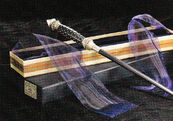(Undo revision 423869 by 115.133.64.103 (talk)) |
|||
| Line 15: | Line 15: | ||
A '''wand''' is a tool used by [[Wizards|wizards and witches]] to channel magical powers. Most spells are done with the aid of wands. It is possible to do [[magic]] without a wand, but is very difficult and requires much concentration and skill. Only advanced wizards can perform [[Wandless spell|spells without the use of wands]].<ref name="HBP">''[[Harry Potter and the Half-Blood Prince]]''</ref> Wands are "quasi-sentient," and as close to animate as an object can get because they are imbued with a great deal of magic.<ref name="PCI">[http://www.accio-quote.org/articles/2007/1224-pottercast-anelli.html 24 December 2007 PotterCast Interviews with J.K. Rowling]</ref> |
A '''wand''' is a tool used by [[Wizards|wizards and witches]] to channel magical powers. Most spells are done with the aid of wands. It is possible to do [[magic]] without a wand, but is very difficult and requires much concentration and skill. Only advanced wizards can perform [[Wandless spell|spells without the use of wands]].<ref name="HBP">''[[Harry Potter and the Half-Blood Prince]]''</ref> Wands are "quasi-sentient," and as close to animate as an object can get because they are imbued with a great deal of magic.<ref name="PCI">[http://www.accio-quote.org/articles/2007/1224-pottercast-anelli.html 24 December 2007 PotterCast Interviews with J.K. Rowling]</ref> |
||
| − | Although the [[wand core]]s may come from the same creature, or the [[Wand wood|wood]] may come from the same tree, no two existing wands are exactly alike. |
+ | Although the [[wand core]]s may come from the same creature, or the [[Wand wood|wood]] may come from the same tree, no two existing wands are exactly alike. |
==Wands and Wandlore== |
==Wands and Wandlore== |
||
| Line 25: | Line 25: | ||
Generally, wands are long, thin rods of [[Wand wood|wood]] with a magical substance embedded into their [[wand core|core]]. Some of the woods used include holly, hawthorn, oak, vine, rosewood, blackthorn, willow, ash, mahogany, yew, and elder. The [[Wand core|cores]] that have been documented are [[Phoenix]] [[Phoenix feather|feather]], [[Dragon]] [[Dragon heartstring|heartstring]], [[Veela]] [[Veela hair|hair]], [[Unicorn]] [[Unicorn hair|hair]], and [[Thestral]] [[Thestral tail hair|hair]]. The wandmaker [[Ollivander]] mentioned that he did not use Veela hair, as it made for "temperamental" wands. It is possible that other magical substances may be used for cores, but none have yet been specified. |
Generally, wands are long, thin rods of [[Wand wood|wood]] with a magical substance embedded into their [[wand core|core]]. Some of the woods used include holly, hawthorn, oak, vine, rosewood, blackthorn, willow, ash, mahogany, yew, and elder. The [[Wand core|cores]] that have been documented are [[Phoenix]] [[Phoenix feather|feather]], [[Dragon]] [[Dragon heartstring|heartstring]], [[Veela]] [[Veela hair|hair]], [[Unicorn]] [[Unicorn hair|hair]], and [[Thestral]] [[Thestral tail hair|hair]]. The wandmaker [[Ollivander]] mentioned that he did not use Veela hair, as it made for "temperamental" wands. It is possible that other magical substances may be used for cores, but none have yet been specified. |
||
| − | Other important characteristics of a wand are its length and its rigidity, ranging from "unyielding" to "springy." These factors have some effect on the overall use of the wand, but it is currently unknown what they actually do. The characteristics of a wand also seem to have some influence over which kinds of magic the wand is particularly suited for. For example, [[James Potter I|James Potter]]'s wand was quite good at [[Transfiguration (class)|Transfiguration]], and [[Lily Evans]]' wand was described as being excellent for [[Charms (class)|Charms]] work. |
+ | Other important characteristics of a wand are its length and its rigidity, ranging from "unyielding" to "springy." These factors have some effect on the overall use of the wand, but it is currently unknown what they actually do. The characteristics of a wand also seem to have some influence over which kinds of magic the wand is particularly suited for. For example, [[James Potter I|James Potter]]'s wand was quite good at [[Transfiguration (class)|Transfiguration]], and [[Lily Evans]]' wand was described as being excellent for [[Charms (class)|Charms]] work. |
The exact process of making a wand is not known. Likely, it is as difficult and complex as wandlore itself. |
The exact process of making a wand is not known. Likely, it is as difficult and complex as wandlore itself. |
||
| Line 31: | Line 31: | ||
==General wand properties== |
==General wand properties== |
||
[[File:1584639.jpg|thumb|right|Various wands.]] |
[[File:1584639.jpg|thumb|right|Various wands.]] |
||
| − | In almost all documented cases, the wand chooses the wizard. This is due to the unique character of each wand, which must match that of the wizard, as the wizard may not be able to perform magic if his and his wand's characters conflict, or the magic may be sub-par to magic performed with the wizard's own wand.<ref name="DH"/> When trying out different wands, an aspiring wizard may cause some damage when he encounters wands that don't get along with him.<ref name="PS">''[[Harry Potter and the Philosopher's Stone]]''</ref> Unfortunately, such trial and error is the only way to find a wand that matches the witch or wizard, and so [[Ollivander|Mr. Ollivander]] has become used to his store becoming damaged on a constant basis. |
+ | In almost all documented cases, the wand chooses the wizard. This is due to the unique character of each wand, which must match that of the wizard, as the wizard may not be able to perform magic if his and his wand's characters conflict, or the magic may be sub-par to magic performed with the wizard's own wand.<ref name="DH"/> When trying out different wands, an aspiring wizard may cause some damage when he encounters wands that don't get along with him.<ref name="PS">''[[Harry Potter and the Philosopher's Stone]]''</ref> Unfortunately, such trial and error is the only way to find a wand that matches the witch or wizard, and so [[Ollivander|Mr. Ollivander]] has become used to his store becoming damaged on a constant basis. |
It is theorised that the wand's length is directly proportional to the wizard's height: the longer the wand, the taller the wizard, and the shorter the wand, the shorter the wizard. However, this theory has not been confirmed. Examples of this have been found, as in [[Dolores Umbridge]]'s short wand, and [[Ronald Weasley|Ron Weasley]]'s and [[Rubeus Hagrid]]'s long ones. If this is the case it may only be proportionate to the user's height at the time the wand is purchased, as Draco Malfoy's wand was shorter than Harry's but Draco ended up taller than Harry. |
It is theorised that the wand's length is directly proportional to the wizard's height: the longer the wand, the taller the wizard, and the shorter the wand, the shorter the wizard. However, this theory has not been confirmed. Examples of this have been found, as in [[Dolores Umbridge]]'s short wand, and [[Ronald Weasley|Ron Weasley]]'s and [[Rubeus Hagrid]]'s long ones. If this is the case it may only be proportionate to the user's height at the time the wand is purchased, as Draco Malfoy's wand was shorter than Harry's but Draco ended up taller than Harry. |
||
| − | Since numbers have known magical properties, it's also possible that the wand's length have some symbolic meaning related to their owners, much like their core. For example, the wand of Tom Riddle, a reputed dark wizard, measures 13½ inches and thirteen is commonly an omen of misforutne or evil in the folklore and religion of various cultures around the world. |
+ | Since numbers have known magical properties, it's also possible that the wand's length have some symbolic meaning related to their owners, much like their core. For example, the wand of Tom Riddle, a reputed dark wizard, measures 13½ inches and thirteen is commonly an omen of misforutne or evil in the folklore and religion of various cultures around the world. |
Examples of damage caused by "mismatched" wands were seen in [[1991]], where wand boxes flew off of shelves and banged into walls and when a glass jar on a shelf was shattered as a result of [[Harry Potter]] waving the wrong sort of wands. He tried out many wands before he found the one that chose him. Apparently, a warm feeling is felt when the wizard or witch chooses the right wand, and the wand sometimes emits a few sparks or does some similar small sign of magic.<ref name="PS"/> |
Examples of damage caused by "mismatched" wands were seen in [[1991]], where wand boxes flew off of shelves and banged into walls and when a glass jar on a shelf was shattered as a result of [[Harry Potter]] waving the wrong sort of wands. He tried out many wands before he found the one that chose him. Apparently, a warm feeling is felt when the wizard or witch chooses the right wand, and the wand sometimes emits a few sparks or does some similar small sign of magic.<ref name="PS"/> |
||
| Line 126: | Line 126: | ||
|Harry Potter (wand #2) |
|Harry Potter (wand #2) |
||
|blackthorn |
|blackthorn |
||
| + | |unknown |
||
| − | |10" |
||
|unknown |
|unknown |
||
|This [[blackthorn wand|wand]] was taken from a [[Snatcher]] by Ron Weasley in [[1997]], and used by Harry until [[1998]], when he took [[Draco Malfoy's wand]]. |
|This [[blackthorn wand|wand]] was taken from a [[Snatcher]] by Ron Weasley in [[1997]], and used by Harry until [[1998]], when he took [[Draco Malfoy's wand]]. |
||
| Line 290: | Line 290: | ||
Fred and George Weasley's wand.jpg|Fred and George Weasley's wands |
Fred and George Weasley's wand.jpg|Fred and George Weasley's wands |
||
</gallery> |
</gallery> |
||
| + | |||
==Behind the scenes== |
==Behind the scenes== |
||
Revision as of 15:24, 17 November 2010
- "The wand chooses the wizard... it's not always clear why."
- — Ollivander[src]
A wand is a tool used by wizards and witches to channel magical powers. Most spells are done with the aid of wands. It is possible to do magic without a wand, but is very difficult and requires much concentration and skill. Only advanced wizards can perform spells without the use of wands.[1] Wands are "quasi-sentient," and as close to animate as an object can get because they are imbued with a great deal of magic.[2]
Although the wand cores may come from the same creature, or the wood may come from the same tree, no two existing wands are exactly alike.
Wands and Wandlore
Wandlore is a specific class of magic that refers to the history and magical properties of wands. Mr. Ollivander claims that it is a "complex and mysterious branch of magic."[3] The idea that a wand chooses the wizard is a part of wandlore, as is the idea that wands can switch allegiance.
Materials

Hermione Granger's wand (vine wood, 10¾ inches, dragon heartstring).
Generally, wands are long, thin rods of wood with a magical substance embedded into their core. Some of the woods used include holly, hawthorn, oak, vine, rosewood, blackthorn, willow, ash, mahogany, yew, and elder. The cores that have been documented are Phoenix feather, Dragon heartstring, Veela hair, Unicorn hair, and Thestral hair. The wandmaker Ollivander mentioned that he did not use Veela hair, as it made for "temperamental" wands. It is possible that other magical substances may be used for cores, but none have yet been specified.
Other important characteristics of a wand are its length and its rigidity, ranging from "unyielding" to "springy." These factors have some effect on the overall use of the wand, but it is currently unknown what they actually do. The characteristics of a wand also seem to have some influence over which kinds of magic the wand is particularly suited for. For example, James Potter's wand was quite good at Transfiguration, and Lily Evans' wand was described as being excellent for Charms work.
The exact process of making a wand is not known. Likely, it is as difficult and complex as wandlore itself.
General wand properties
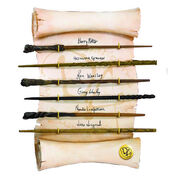
Various wands.
In almost all documented cases, the wand chooses the wizard. This is due to the unique character of each wand, which must match that of the wizard, as the wizard may not be able to perform magic if his and his wand's characters conflict, or the magic may be sub-par to magic performed with the wizard's own wand.[3] When trying out different wands, an aspiring wizard may cause some damage when he encounters wands that don't get along with him.[4] Unfortunately, such trial and error is the only way to find a wand that matches the witch or wizard, and so Mr. Ollivander has become used to his store becoming damaged on a constant basis.
It is theorised that the wand's length is directly proportional to the wizard's height: the longer the wand, the taller the wizard, and the shorter the wand, the shorter the wizard. However, this theory has not been confirmed. Examples of this have been found, as in Dolores Umbridge's short wand, and Ron Weasley's and Rubeus Hagrid's long ones. If this is the case it may only be proportionate to the user's height at the time the wand is purchased, as Draco Malfoy's wand was shorter than Harry's but Draco ended up taller than Harry.
Since numbers have known magical properties, it's also possible that the wand's length have some symbolic meaning related to their owners, much like their core. For example, the wand of Tom Riddle, a reputed dark wizard, measures 13½ inches and thirteen is commonly an omen of misforutne or evil in the folklore and religion of various cultures around the world.
Examples of damage caused by "mismatched" wands were seen in 1991, where wand boxes flew off of shelves and banged into walls and when a glass jar on a shelf was shattered as a result of Harry Potter waving the wrong sort of wands. He tried out many wands before he found the one that chose him. Apparently, a warm feeling is felt when the wizard or witch chooses the right wand, and the wand sometimes emits a few sparks or does some similar small sign of magic.[4]
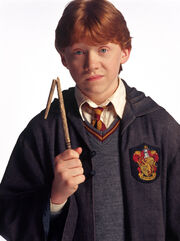
Ron Weasley with a broken wand.
Wands are capable of changing masters. When a wand's master is disarmed, stunned, or killed, but not had their wand snatched from their hand, the wand will accept the old master's attacker as its new master. This will occur even if the wand in question is not in the possession of either of the two people involved.[3] However, most wands share an affinity with their masters and will not easily discontinue its allegiance with the previous master; furthermore, wands forcibly taken in circumstances of purely competitive or friendly nature, or are stolen without attacking the previous master will not change allegiance.[5]
Wands can be broken by spells or by physical damage. Wands in this condition will have greatly reduced magical abilities. Even when repaired, the wand's magic will not improve and the wand may break again while performing magic. The Elder Wand is able to completely repair broken wands, although this ability may be lost if the current master (Harry Potter) dies undefeated, as most of the wand's power would disappear with him.[3]
Wands are quasi-sentient, meaning that while they cannot think or communicate like a human, they can perform certain actions through their own will. This could be how they choose their wizard, and also explains how Harry's wand was able to act on its own against Voldemort.[3] Wands sometimes show hints of their personality, such as shyness (reluctance to get out of their box before being purchased).[6]
Rights of usage
Non-human beings, such as goblins and house-elves, are prohibited from owning or using wands. For goblins in particular, this has been a point of contention with the wizarding community, and has been the cause of some outbreaks of violence. It is unknown if any formal prohibiton exists against muggles possessing a wand, as they would be unable to use them anyway, although it could be considered a breach of the International Statute of Wizarding Secrecy.
During the last year of the Second Wizarding War, the British Ministry of Magic was overthrown by the Death Eaters, and new laws were put into effect. Muggle-born witches and wizards were regarded as having "stolen" their magic from "real" witches and wizards, and their wands were confiscated. Those who were not imprisoned were usually left destitute.
Makers
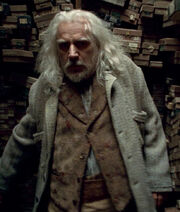
Gregorovitch.
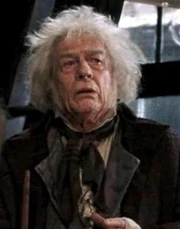
Ollivander.
There are many makers of wands, but the best known, and most experienced in Britain is Ollivander's. The wandmaking establishment has been making wands since 382 BC and is located in Diagon Alley, London. Mr. Ollivander went missing in the summer of 1996[1], until he was discovered by Harry, Ron and Hermione and rescued by the house-elf Dobby in 1998. He had been kidnapped by Death Eaters on Voldemort's orders. After their rescue, Ollivander provided Harry with information about the Elder Wand and about how a wand passes ownership.
There were more British wandmakers, such as Jimmy Kiddell, but their wands were not as good as Ollivander's.
Another notable wand maker was Gregorovitch, who had made the wand of Viktor Krum, and once wielded the Elder Wand. In 1997 he was tracked down and questioned by Voldemort in Voldemort's quest to find the Elder Wand. Once Voldemort finished questioning Gregorovitch, he murdered him.[3]
According to legend, Death created the Elder Wand, the most powerful wand in existence, from the branch of an elder tree. Albus Dumbledore, however, believed it was more likely that the wand had been created by Antioch Peverell himself.
Known wands
| Owner | Wood | Length | Core | Notes |
|---|---|---|---|---|
| Albus Dumbledore (wand #1) | unknown | unknown | unknown | As Dumbledore won the Elder Wand after a duel, it can be assumed that he started with a different wand. |
| Albus Dumbledore (wand #2) | elder | 15" | Thestral hair | The Elder Wand, one of the Deathly Hallows. Also known as the Deathstick and the Wand of Destiny. |
| Bellatrix Lestrange | walnut | 12¾" | Dragon heartstring | This wand is described as "unyielding;" passed into the possession of Hermione Granger after the Skirmish at Malfoy Manor in 1998. |
| Cedric Diggory | ash | 12¼" | Unicorn hair | This wand was "pleasantly springy;" hair from particularly fine male unicorn (seventeen hands high), which nearly gored Mr. Ollivander with its horn after he plucked its tail hair. |
| Dolores Umbridge | unknown | unknown | unknown | This wand is described as "unusually short;" broken by a Centaur's hoof in June 1996 in the Forbidden Forest. |
| Draco Malfoy | hawthorn | 10" | Unicorn hair | "Reasonably springy;" this wand passed into the possession of Harry Potter after the Skirmish at Malfoy Manor in 1998 until Harry came into possession of the Elder Wand and mended his first wand. |
| Fleur Delacour | rosewood | 9½" | Veela hair | This wand is described as "inflexible;" the core is a hair from Fleur's grandmother, who was a Veela. |
| Gellert Grindelwald | elder | 15" | Thestral hair | The Elder Wand. Taken from him by Albus Dumbledore after a legendary duel in 1945. |
| Harry Potter (wand #1) | holly | 11" | Phoenix feather | Nice and supple; "Brother" to Voldemort's wand - the core tail feathers are both from Fawkes; broken in December 1997 while fleeing from Godric's Hollow; repaired with the Elder Wand in May 1998. |
| Harry Potter (wand #2) | blackthorn | unknown | unknown | This wand was taken from a Snatcher by Ron Weasley in 1997, and used by Harry until 1998, when he took Draco Malfoy's wand. |
| Harry Potter (wand #3) | hawthorn | 10" | Unicorn hair | This was Draco Malfoy's wand and was described as "reasonably springy;" passed into the possession of Harry Potter after the Skirmish at Malfoy Manor in 1998 until Harry came into possession of the Elder Wand and mended his first wand. |
| Harry Potter (wand #4) | elder | 15" | Thestral hair | After disarming Draco Malfoy of his wand in 1998, Harry also gained control of the Elder Wand. He used the wand only once, in May of 1998 in order to repair his phoenix wand, after which he returned it to Albus Dumbledore's grave. |
| Hermione Granger (wand #1) | vine | 10¾" | Dragon heartstring | This wand was confiscated when the trio was captured by Snatchers in 1998. |
| Hermione Granger (wand #2) | walnut | 12¾" | Dragon heartstring | This was Bellatrix Lestrange's wand and was described as "unyielding;" passed into the possession of Hermione Granger after the Skirmish at Malfoy Manor in 1998. |
| James Potter | mahogany | 11" | unknown | This wand was "pliable" and "excellent for transfiguration." |
| Lily Evans | willow | 10¼" | unknown | This wand was "swishy" and "nice for Charm work." |
| Lucius Malfoy | elm | unknown | Dragon heartstring | This wand was kept in a snake-headed walking stick that Lucius carried; "borrowed" by Lord Voldemort and destroyed by Harry Potter's wand during the Battle over Little Whinging in 1997. |
| Luna Lovegood (wand #1) | unknown | unknown | unknown | This wand was taken from Luna when she was captured by Death Eaters and imprisoned in Malfoy Manor in 1997. |
| Luna Lovegood (wand #2) | unknown | unknown | unknown | This wand was made for Luna by Ollivander in 1998. |
| Mary Cattermole | cherry | 8¾" | Unicorn hair | This wand was confiscated by the Muggle-Born Registration Commission in 1997. |
| Minerva McGonagall | unknown | unknown | unknown | This wand was most likely purchased from Ollivander's in 1937 when she was eleven. |
| Narcissa Malfoy | unknown | unknown | unknown | Narcissa lent her wand to her son Draco following the Skirmish at Malfoy Manor, when his wand was taken by Harry Potter. Draco subsequently lost it in the Room of Requirement. |
| Neville Longbottom (wand #1) | unknown | unknown | unknown | Belonged to Neville's father Frank; broken by Antonin Dolohov in June 1996 during the Battle of the Department of Mysteries. |
| Neville Longbottom (wand #2) | cherry | 13" | Unicorn hair | May have been one of the last wands Mr. Ollivander sold before he disappeared in 1996. |
| Peter Pettigrew | chestnut | 9¼" | Dragon heartstring | This wand was "brittle;" owned by Pettigrew only since Ollivander had been kidnapped of 1996; passed into the possession of Ron Weasley after the Skirmish at Malfoy Manor in 1998. |
| Ron Weasley (wand #1) | ash | 12" | Unicorn hair | Ron's brother Charlie's old wand; severely damaged in September 1992 after a run-in with the Whomping Willow. |
| Ron Weasley (wand #2) | willow | 14" | Unicorn hair | Purchased with his father's winnings from a Daily Prophet draw. Taken from him by Snatchers and replaced with Peter Pettigrew's wand. |
| Ron Weasley (wand #3) | chestnut | 9¼" | Dragon heartstring | This was Pettigrew's wand and was described as "brittle." During the Skirmish at Malfoy Manor, Ron took this wand from Pettigrew and used from then on as his own wand was taken by Snatchers. |
| Rubeus Hagrid | oak | 16" | unknown | This wand is "rather bendy;" snapped in half when Hagrid was expelled from Hogwarts during his third year - the pieces are certainly hidden in Hagrid's pink umbrella. |
| Seamus Finnigan (Seamus Finnigan's wand) | Unknown | Unknown | Unknown | Used this wand to set fire to feather in 1st year. |
| Selwyn | unknown | unknown | unknown | This wand was taken by Lord Voldemort during the Battle over Little Whinging after the wand he was using was destroyed. |
| Tom Marvolo Riddle a.k.a. Lord Voldemort | yew | 13½" | Phoenix feather | This wand is "brother" to Harry Potter's wand - the core tail feathers are both from Fawkes. |
| Viktor Krum | hornbeam | 10¼" | Dragon heartstring | This wand is thicker than usual, "quite rigid," and made by Gregorovitch. |
Behind the scenes
- Wands used in the Harry Potter films are shown to have clear handles for wizards to hold onto them such as the bone handle of Voldemort's yew wand. The books however do not describe such handles. In fact all the pictures by Mary GrandPré in the American editions depict all wands as thin rods. This is supported by such things as Ron's Slug-Vomiting Charm coming out the "wrong end" of the wand and Harry's feeling that his wand is a "strip of wood" compared to a Dragon. (This is contradicted in the US Hardcover edition of Deathly Hallows on page 343, during Voldemort's flashback of the night he murdered Lily and James. ..."he fingered the handle of his wand.")
- Also, in the films, the wands are shown a couple of inches longer than they are shown in the books. The films seem to include more gestures when using a wand, not just waving it and pointing it. The different styles were shown properly in the film version of the Battle of the Department of Mysteries.
- J. K. Rowling used a Celtic calendar to assign certain types of woods to Ron Weasley, Hermione Granger, and Harry Potter based on their birthdates.[7]
- In the first and second films, wands look quite plain. The appearance of wands drastically change in the film adaptation of Harry Potter and the Prisoner of Azkaban, on which the wands are given distinctive shapes and carvings, reflecting the owner's personality.
- Devon Murray, who plays Seamus Finnigan in the Harry Potter films, has the record for breaking the most prop wands. His record as of the film version of Order of the Phoenix is breaking ten of them. [8]
- J.K. Rowling has said that Muggles cannot use a magic wand, yet residual power stored in a wand may discharge at odd moments, having potentially disastrous effects for a non-wizard.[9]
- Wands are often buried or burned when the owner dies.[10]
- The right to carry a wand at all times was established by the International Confederation of Wizards in 1692, when Muggle persecution was at its height and the wizards were planning their retreat into hiding.[11]
- Although known to made of Holly, an extremely white-colored wood, Harry Potter's movie wand is made from a darker, more photogenic, wood species.
Appearances
- Harry Potter and the Philosopher's Stone (First appearance)
- Harry Potter and the Philosopher's Stone (film)
- Harry Potter and the Philosopher's Stone (video game)
- Harry Potter and the Chamber of Secrets
- Harry Potter and the Chamber of Secrets (film)
- Harry Potter and the Chamber of Secrets (video game)
- Harry Potter and the Prisoner of Azkaban
- Harry Potter and the Prisoner of Azkaban (film)
- Harry Potter and the Prisoner of Azkaban (video game)
- Harry Potter and the Goblet of Fire
- Harry Potter and the Goblet of Fire (film)
- Harry Potter and the Goblet of Fire (video game)
- Harry Potter and the Order of the Phoenix
- Harry Potter and the Order of the Phoenix (film)
- Harry Potter and the Order of the Phoenix (video game)
- Harry Potter and the Half-Blood Prince
- Harry Potter and the Half-Blood Prince (film)
- Harry Potter and the Half-Blood Prince (video game)
- Harry Potter and the Deathly Hallows
- Harry Potter and the Deathly Hallows (film)
- Lego Harry Potter: Years 1-4
- The Tales of Beedle the Bard
Notes and references
- ↑ 1.0 1.1 Harry Potter and the Half-Blood Prince
- ↑ 24 December 2007 PotterCast Interviews with J.K. Rowling
- ↑ 3.0 3.1 3.2 3.3 3.4 3.5 Harry Potter and the Deathly Hallows
- ↑ 4.0 4.1 Harry Potter and the Philosopher's Stone
- ↑ Pottercast 131
- ↑ "Wand Fitting at Ollivander's" on Youtube, showing a wand fitting at The Wizarding World of Harry Potter
- ↑ Extra Stuff at J.K. Rowling's Official Site
- ↑ Devon Murray on Wikipedia
- ↑ The Tales of Beedle the Bard (real), pg 83
- ↑ The Tales of Beedle the Bard (real), pg 104
- ↑ Quidditch Through the Ages (real), pg 28

















